


Sun's Position Over Earth
(to update, reload page)
Courtesy:
Fourmilab Switzerland
Today's Sunrise & Sunset
Earth Tilt, Sunrise & Sunset
Day, Night & the Analemma
No Sunlight on Entire Earth
The Sun, Earth's parent star, is a gigantic spinning sphere of incredibly hot gases! It rotates in the same direction that the major planets orbit it. (1.6.x)
Due to Earth's orbital motion around it, the Sun appears to circle the sky (eastward through the background of fixed stars) each year. (1.6.x)
When the Moon moves directly between Earth and the Sun, spectacular Solar Eclipses can occur. (1.6.x)
Are you unfamiliar with our 1.6.x and 1.4.1 links? For an explanation click here.
THE SOLAR ANALEMMA
The Sun's Signature
If the Sun's position is noted at the same time and from the same place day after day, in a year it traces a large figure-8 in the sky! Astronomers call this the solar analemma.
Sun's Current Position
on the Analemma
Also often referred to as the Sun's Signature, this effect is the result of Earth's obliquity and orbital eccentricity being slightly "out of synch" with one another. Here's a video that displays how much each of these factors contributes to the solar analemma.
This revealing animation ![]() from the Washington Post shows the solar analemma's relationship to Earth's annual journey around the Sun.
from the Washington Post shows the solar analemma's relationship to Earth's annual journey around the Sun.
Note: if you search the web for "solar analemma", you'll find examples claiming to be actual series of photos taken over a year's time. Unfortu-nately most are fakes! They are very easy to spot, as they show shadows that the Sun could not possibly cast from where it is in the photos!
SUNDIALS
Sundials Have been used for thousands of years!
Wikipedia page
N Am. Sundial Society
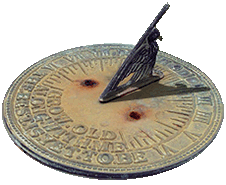
SUN ACTIVITIES
MAKE A PAPER
MODEL SUNDIAL!
CANON has a cool website that offers free downloads, including one that lets you make a cool paper model Sundial. ![]() Chart the dial's shadow throught the day—and the year! When is the shadow longest? Shortest?
Chart the dial's shadow throught the day—and the year! When is the shadow longest? Shortest?
MAKE A PAPER
MODEL OF THE SUN'S STRUCTURE
The same CANON website also lets you download the components to make a cool 3D paper model of the Sun's structure. This labeled cut- away globe reveals the inner secrets of the Sun!
MAKE A SCALE MODEL SOLAR SYSTEM SCROLL
Here's a NASA/JPL activity that lets you produce a great visual aid that you can show family and friends—a Solar System Scroll that will help them understand the sizes of the planets and the distances between them.
CELES-TIPS
The following will help you enjoy this page's 1.6.x and 1.4.1 links that run events directly in CELESTIA. If you're new to the program, these tips will also help you learn to use it.
You'll find more information about many of CELESTIA's controls on our Learning Center page.
The other major planets
see a Sun far different
in size than the one
we see from Earth!
THE SUN
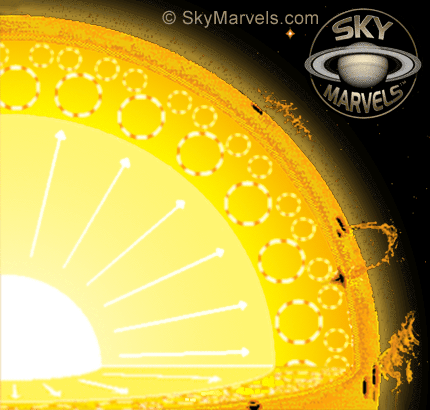
 KEEP SAFE! It is never safe to look directly at the real Sun with the naked eye! Moreover, looking at it through a telescope, binoculars, camera, etc. without proper safeguards—even for an instant—can cause permanent blindness! NEVER DO IT! To learn how to safely "observe" the real Sun, consult the professionals at your local planetarium or observatory.
KEEP SAFE! It is never safe to look directly at the real Sun with the naked eye! Moreover, looking at it through a telescope, binoculars, camera, etc. without proper safeguards—even for an instant—can cause permanent blindness! NEVER DO IT! To learn how to safely "observe" the real Sun, consult the professionals at your local planetarium or observatory.
Current Distance and Apparent Size from Earth
Current Sunsize vs Moonsize
Current Location in the Constellations
Current Location on the Analemma
Current Earth & Moon Viewed from Sun Interactive
Today's Sunrise and Sunset at your location
How Long the Sun Is in Your Sky Today
Latest Major Solar Activity Visible from Earth:
Sunspots
![]() Prominences
Prominences
![]() Solar Cycle
Solar Cycle ![]()
![]()
Sun Location and Motion:
In Milky Way Galaxy resides in Orion Arm ![]()
![]()
In Local Cloud
![]() within 10 parsecs (32.6 light yrs)
within 10 parsecs (32.6 light yrs)
Around Sol. Sys. Barycenter
![]() Gravity Simulator
Gravity Simulator
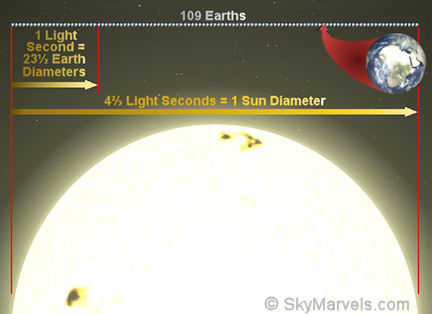
Size: "Visible Surface" Compare Compare in 3-D
Radius: 695,700 km (nominal, defined by IAU 2015)
Diameter: 1,391,400 km
Diameter (Earth = 1): 109.1
Diameter (Jupiter = 1): 9.73
Diameter in Light-Seconds: 4.64 Light-Seconds
Sun-Size Comparisons:
NASA
NASA
NASA/ESA
NASA
NASA
The Sun is so immense that the
Moon's orbit would easily fit inside!
Rotational Flattening: 0.00005
Mass (Earth = 1): 333,000
Volume (Earth = 1): 1,300,000
Mean Density:
(Water = 1): 1.408
(Earth = 1): 0.255
"Surface" Gravity (Earth = 1): 27.96
Escape Velocity:
2,223,360 km/hr
(Earth = 1): 55.2
Inclination of Axis to Ecliptic: 7.25° (1.6.x)
Inclination of Axis to Galactic Plane: 67.2°
Magnitude:
Apparent: -26.74
Absolute: 4.83
Luminosity: 384.6 x 10e24 J/s
SUN'S APPARENT MOTION ALONG THE ECLIPTIC
Sun Apparent Motion:
Average through Constellations: 0.9865°/day ~East
Note: the Sun moves "due east" through Constel-
lations (background sky) only at Solstices
Average Daily through Local Sky: 15°/hr ~West
approx. 1/2 Apparent Solar Dia./min ~West
approx. 1 Apparent Solar Dia. every 2 min ~West
Note: the Sun moves "due west" through the sky
only at the Solstices
Northernmost Declination: 23.44° (at Jun Solstice)
Southernmost Declination: -23.44° (at Dec Solstice)
Declination at Equinoxes: 0°
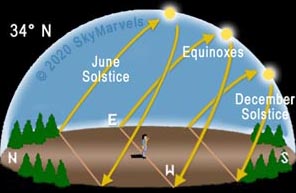
The Sun's Skypath Poster
Motion of the Sun Simulator
Solar Rotation: (varies with Latitude)
Adopted Period at 16° Latitude:
Sidereal (in Earth hours): 609.12
Sidereal (in Earth Sidereal Days): 25.559
Note: Earth Day Lengths
Mean Solar: 24.0000 hours (24h00m00s)
Sidereal: 23.9345 hr (23h56m4.1s)
At Equator: 24.5 days
At Mid Latitudes: 27 days (Sun's average rotation)
At Poles: 35 days
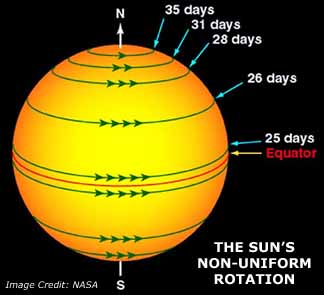
North Polar Direction (on Ref. Date 2000 Jan 1.5 ): ![]()
Right Ascension: 19h 04m 30s (286.13°)
Declination: 63° 52' 12" (63.87°)
In Constellation "Draco"
NASA's Overview of the Sun
Sun Surface Features & Activity:
Solar Cycle: 11.4 yr (average, NASA video)
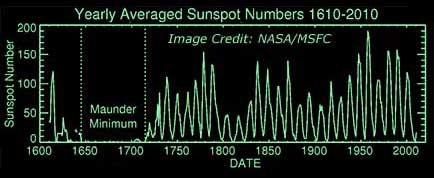 Sunspots
Sunspots ![]() Current
Current
Vids & Images:
![]()
![]()
![]()
![]()
![]()
![]()
Prominences ![]() Current
Current
Vids & Images:
![]()
![]()
![]()
![]()
Solar Flares ![]()
Vids & Images:
![]()
![]()
![]()
![]()
![]()
Awesome NASA-Goddard SVS videos:
Heliophysics Gallery
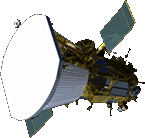 Spacecraft in 3-D:
Spacecraft in 3-D:
Parker Solar Probe #2 ![]()
![]()
SDO ![]()
![]()
SOHO ![]()
![]()
Solar Orbiter ![]()
![]()
Distance from Earth: Current
Mean: 1 AU (essentially defines measurement)
Mean: 149,597,870.7 km (defined in 2012)
Min (at Earth's Perihelion): 147,098,000 km
Date of: betw. Jan 2 and Jan 6 (current era)
Max (at Earth's Aphelion): 152,096,400 km
Date of: betw. Jul 3 and Jul 7 (current era)
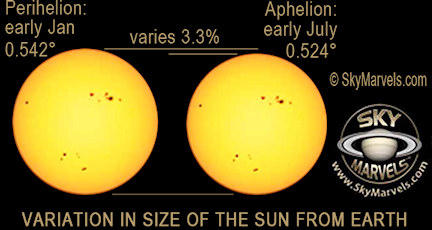 Apparent Size from Earth: Current
Apparent Size from Earth: Current
Mean: 0.533° (31.98 arc-min)
Minimum: 0.524° (31.45 arc-min)
Maximum: 0.542° (32.53 arc-min)
Current Apparent Sun Size vs Moon Size

Earth's Mean Tilt Today
relative to the Sun
(to update, reload page)
Current Apparent Sizes
(geocentric)
Donate safely with: PayPal
and receive one or more
Sky-Gifts. Your support is greatly appreciated!
NOTE: you do not need a PayPal account to donate.
SKY VIEWING
SOLAR SYSTEM
THE SUN
MERCURY
VENUS
EARTH
THE MOON
MARS
JUPITER
SATURN
URANUS
NEPTUNE
SMALLER WORLDS
STELLAR OBJECTS
EXOPLANETS
DEEP-SKY OBJECTS
SCALE OF THE COSMOS
———————
SKY-FUN / SKY-GAMES
UPCOMING
Eclipses: Only Solar Eclipses
this year are Partial.
Next Transits:
NASA's LATEST
SDO: Solar Dynamics Obser.
Sun Activity: Today's Vids
Sunspots
Prominences
AIA 171 (gold)
AIA 193 (bronze)
AIA 1700 (pink)
Interactive Tool
ESA's LATEST
SUN FUN FACTS
Light requires over 4 seconds to travel one solar diameter! Check it out!
Light from the Sun takes 8 minutes to reach Earth!
Helium was first discovered on the Sun!
The Sun rotates once on its axis in about the same time the Moon takes to orbit Earth —about once a month! But this is a rough average, as different latitudes of the Sun rotate at dififerent rates!
Of everything that has ever been observed in nature, nothing is more perfectly spherical than the Sun!
The surface of the Sun actu- ally pulses! About every two hours forty minutes, at about 6 kmh (4 mph), this pulsation alters the Sun's diameter by nearly 10 km (about 6 miles)! Similar less-dramatic pulses having also been observed, our theories of stellar objects may have to be reviewed!
The Sun accounts for 99.86% of the Solar System's total mass!
SUN INTERACTIVES
QUICK ACCESS LIST
Note: some links are echoed elsewhere on this page and may include descriptive text.
HELIOVIEWER Awesome!
Gravity Simulator Awesome tool! View and map the Sun's continual motion around the Solar System Barycenter!
An excellent Proton-Proton Cycle Interactive
From Andrew Marsh, here are excellent online apps for ad- vanced sky enthusiasts:
2D SunPath
3D SunPath
Earth and Sun
SunPath on Map
Links to interactive features that show the Sun and Solar System in 3-D can be found on our Solar System page
SKYMARVELS™
CELESTIA ADD-ONS FEATURING THE SUN
SKYMARVELS™
POSTERS FEATURING THE SUN
SKYMARVELS™
VIDEOS FEATURING
THE SUN
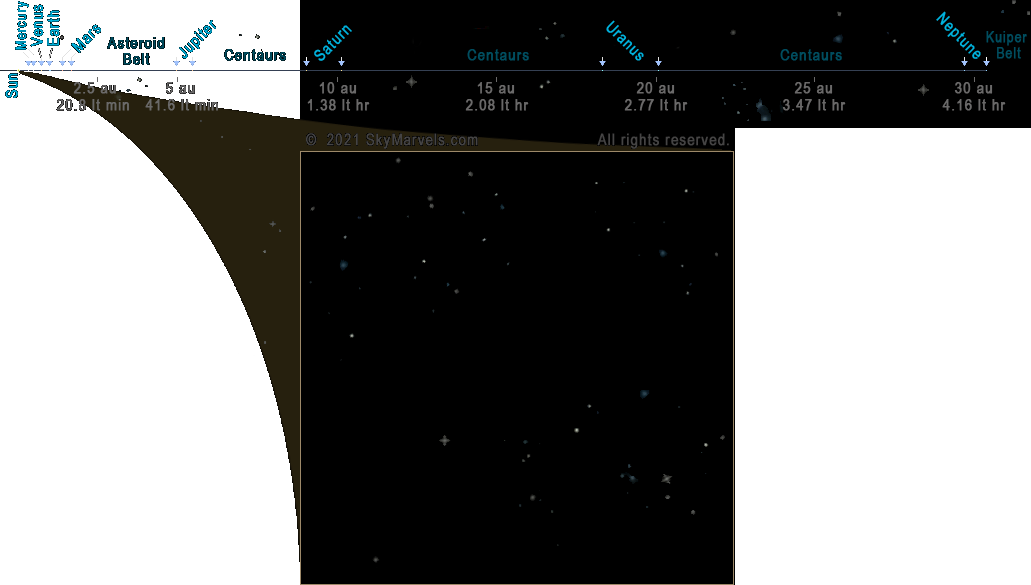
Above, slide the blue pointer left and right "or" click along the Astronomical Unit (au) scale (which also shows light-time) to see the Sun's relative apparent size from Mercury to Neptune! Most browsers (but not Safari) also let you "fine-tune" your slider position with your keyboard's Arrow Keys. All major-planet perihelia and apihelia are shown, though the orbits of Venus and Earth are so circluar that their extremes of distance are less than one pixel apart at this scale! This page opens with the Sun (to right) seen from Earth.
ELEMENTS OF THE MAJOR PLANET ORBITS
| Period (Earth Years) |
Orbital Inclin- ation |
Peri- helion (au) |
Aphe- lion (au) |
|
|---|---|---|---|---|
| Mer | 0.24 | 7.00° | 0.307 | 0.467 |
| Ven | 0.62 | 3.39° | 0.718 | 0.728 |
| Ear | 1.00 | 0.00° | 0.983 | 1.017 |
| Mar | 1.88 | 1.85° | 1.381 | 1.666 |
| Jup | 11.86 | 1.30° | 4.950 | 5.459 |
| Sat | 29.46 | 2.49° | 9.041 | 10.12 |
| Ura | 84.01 | 0.77° | 18.32 | 20.08 |
| Nep | 164.8 | 1.77° | 29.71 | 30.39 |
Solar Eclipses:
Lunar Eclipses:
APPARENT SIZE OF THE SUN
FROM THE MAJOR PLANETS
It is easy to see that Mercury is especially seared by the Sun, and much more at its perihelion than its aphelion! And Mars is close enough to the Sun that the Martian seasons are affected by the planet's orbital eccentricity! Uranus has the greatest difference between its nearest and farthest distances from the Sun! Yet the planet's or- bit is so large that the Sun does not look much different from Uranus's perihelion to its aphelion! What other in- triguing facts will you discover from planet to planet?
As you examine all this, you should also check out the Relative Intensity of Sunlight at the Planets. Since the human eye can adapt so well to varying light levels, you may be surprised by what "daylight looks like" as you venture further out in the Solar System.
Sun Velocity Relative to Nearest Stars: 69,840 km/hr
Orbit:
Around Galactic Center: ![]()
Period: 230,000,000 years (estimated)
Radius: 28,000 light years (estimated)
Velocity: 826,000 km/hr (estimated)
Eccentricity: unknown
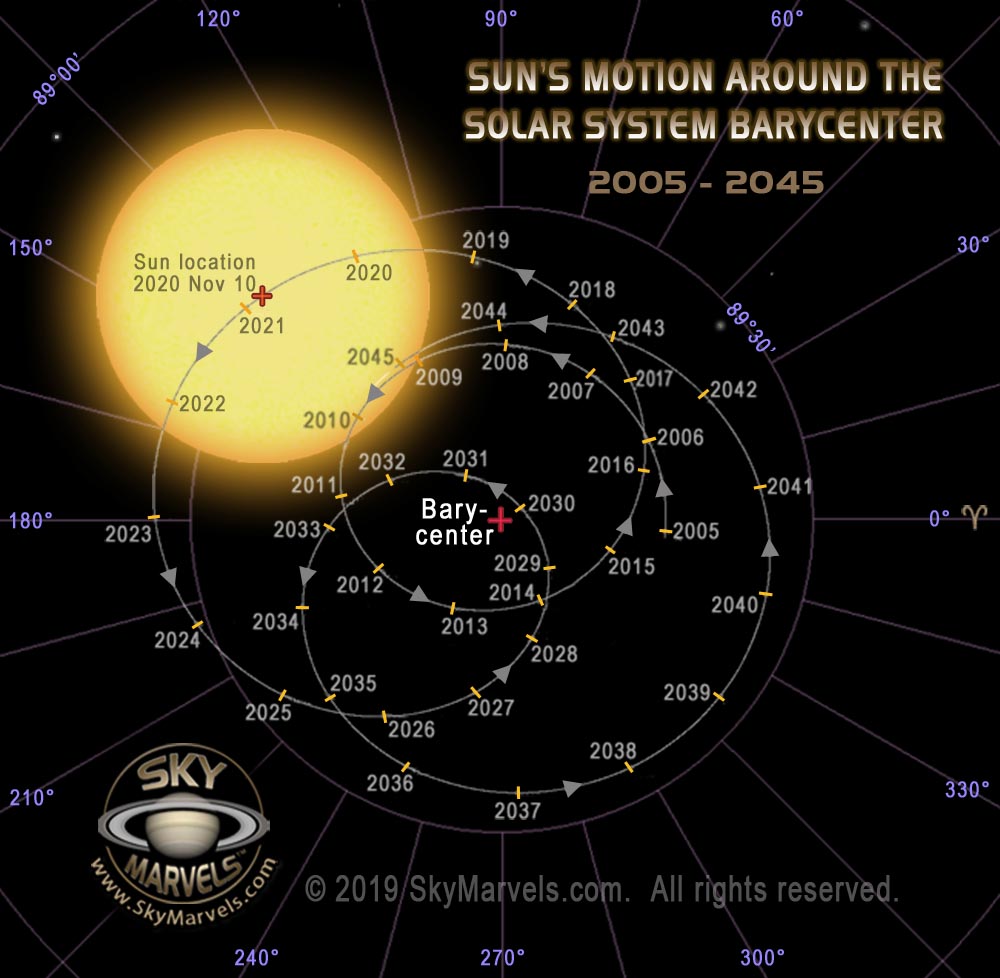
Motion Around Solar System Barycenter ![]()
![]()
Period: very complex
More Maps: 1944 - 1997 2000 - 2050
RASC gif 2000 - 2050 ![]()
Gravity Simulator Map solar motion around the
barycenter! Speed up, slow down, reverse
time. Drag Info boxes out of the way for better
viewing. Delete the effects of each planet or
groups of planets on the Sun's motion! This
is an awesome tool!
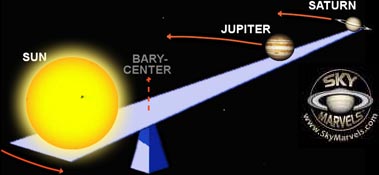
Max Distance: approx. 1,500,000 km
Min Distance: theoretically 0 (zero)
Heliosphere: ![]()
Wikipedia page
Sun Structure:
NASA's Mysteries of the Sun PDF
Temperature:
"Surface": 5,500°C (9,900°F)
Central: 15,600,000°C (28,000,000°F)
Composition (by mass):
"Surface": 70% H, 28% He, 2% (O, N, C, ...)
Central: 35% H, 63% He, 2% (O, N, C, ...)
Ten Most Abundant Elements in the Sun
| Element | Abundance (% of total | Abundance | |
|---|---|---|---|
| number of atoms) | (% of total mass) | ||
| Hydrogen | 91.2 | 71.0 | |
| Helium | 8.7 | 27.1 | |
| Oxygen | 0.078 | 0.97 | |
| Carbon | 0.043 | 0.40 | |
| Nitrogen | 0.0088 | 0.096 | |
| Silicon | 0.0045 | 0.099 | |
| Magnesium | 0.0038 | 0.076 | |
| Neon | 0.0035 | 0.058 | |
| Iron | 0.030 | 0.014 | |
| Sulfur | 0.015 | 0.040 |
Stellar Spectral Type: G2 V
Energy Production Process: Fusion
Cycle: Proton-Proton (P-P) ![]()
Here's an excellent P-P Cycle Interactive
Mass Conversion Rate: 4,300 x 10e6 kg/s
Estimated Age: 4.5 billion years
Estimated Lifetime as Yellow Dwarf: ~10 billion years
Evolution on H-R Diagram ESA Animated GIF

Partial Information Source: NASA Fact Sheets
E C L I P S E S
PRIOR AWESOME U.S. TOTAL SOLAR ECLIPSE:
2024 April 8 Maps Videos
SOLAR ECLIPSE QUICK REFERENCE MAPS
 W A R N I N G ! It is never safe to look directly at the Sun with the naked eye, neither during a Solar Eclipse nor otherwise! Moreover, looking at the Sun—even for an instant—through either a telescope or binoculars without adequate safeguards can cause permanent blindness! NEVER DO IT! To learn how to safely "observe" the Sun and a Solar Eclipse, consult your local planetarium or observatory.
W A R N I N G ! It is never safe to look directly at the Sun with the naked eye, neither during a Solar Eclipse nor otherwise! Moreover, looking at the Sun—even for an instant—through either a telescope or binoculars without adequate safeguards can cause permanent blindness! NEVER DO IT! To learn how to safely "observe" the Sun and a Solar Eclipse, consult your local planetarium or observatory.
NASA's 5 Millenia of Eclipses: Solar Lunar
HISTORY FEATURE:
BEST ECLIPSE IN U.S. HISTORY!
That's how the Total Solar Eclipse of 21 August 2017 is described. That Monday the Moon's shadow whisked across the United States, gracing it with an outstanding sky marvel! NASA Page PDF

Awesome online app and animations from NASA:
Path on Rectangular World Day-Night Map
Why Eclipses Occur Oblique View ![]()
THE SUN'S "APPARENT" MOTION
Due to Earth's orbital motion around the Sun, to Earth- bound observers the Sun appears to move continually eastward along the Ecliptic, each year making a full circle against an essentially fixed background of stars. This can clearly be seen on our Sun's Apparent Motion along the Ecliptic page. Here, and on our Sun's Loca- tion on the Ecliptic throughout the Year page, you can also examine where the Sun lies among the constella- tions at any time of year. For another perspective on this this apparent motion of the Sun, you can view Equinoxes, Solstices and the Sun's Apparent Motion.
GET THE LATEST AWESOME SATELLITE
VIEWS OF THE SUN WITH "HELIOVIEWER"
HelioViewer might just be the best free solar astronomy tool on the web, giving you access to countless actual photos of the Sun from multiple satellites! "Time-step" through photos, and save and even make movies of what you find! This free web-tool is not to be missed.
And to help get you started, here's the direct link to the HelioViewer User Guide.
ADJECTIVES MEANING
"pertaining to or relative to the Sun"
solar (from Latin: Sol)
helio- (combining form; from Greek: Helios)
SOLAR CYCLE
video credit: NASA/Goddard Space Flight Center/
Scientific Visualization Studio
THE SUN: Coronal Mass Ejections & Flux Ropes
video credit: Conceptual Image Lab, NASA
Goddard Space Flight Center
Home Intro News Gallery Sky-Gifts Bonuses Tips
Learning Ctr Help Links Credits Legal Contact Us
© 2007-
by Gary M. Winter. All rights reserved.
Interested in political cartoons and humor?
Check out The HIPPLOMATS™.
GREAT AMERICAN ECLIPSE! BEST ECLIPSE IN AMERICAN HISTORY! BEST ECLIPSE IN U.S. HISTORY! BEST ECLIPSE IN US HISTORY! SkyMarvels, Sky Marvels, SkyMarvels.com, SUN INFO, Sol, the Sun, Our Parent Star, Solar Events, Sun's Current Position over Earth, SOLAR SYSTEM BARYCENTER, Eclipses, Eclipse Calendar, Interactive Eclipse Seasons Calendar, Eclipse Seasons, Today's Sunrise and Sunset, Upcoming Eclipses, the Latest Satellite Views of the Sun, the Solar Analemma, Sun Interactives and more! SOLAR CYCLE PRIMER, The Sun's 11-year Solar Cycle, Sun's Magnetic Field, Sunspots, 11-Year Solar Sunspot Cycle, Solar Maximum, Solar Minimum, Coronal Mass Ejections, Solar Flares, Solar Prominences, Core, Radiative Zone, Convective Zone, Photosphere, Chromosphere, Corona, celestia4all, celestiaforall, CELESTIA, astronomy, space, simulations, animations, downloadable astronomy posters, stars, planets, Inner Planets, Outer Planets, Inferior Planets, Superior Planets, moons, asteroids, comets, Oort Cloud, galaxy, galaxies, Milky Way, Andromeda, globular clusters, binaries, quasars, black holes, supermassive black holes, telescope, telescopes, planetarium, software, freestuff, satellites, add-ons, addons, scripts, eclipses, Solar Eclipses, Lunar Eclipses, Solar Eclipse Finder, Lunar Eclipse Finder, mutual eclipses, transits, occultations, Solar System, CELES-TOOLS, celeSTARrium, CELX, CELX programming, Freebies, Bonuses, multiple views, atronomical unit, light year, parsec, meteors, meteor showers, Perseids, Geminids, Leonids, barycenter, time, Time Zones, tides, alignments, conjunctions, oppositions, seasons, apogees, perigees, aphelion, perihelion, Earth, Luna, Mercury, Venus, Mars, Jupiter, Galilean Moons, Io, Europa, Ganymede, Callisto, Saturn, Titan, rings, Uranus, Neptune, Triton, E-MSpectrum, electromagnetic spectrum, astronaut, equinoxes, solstices, precession, rotation, spin, inclination, tilt, Ecliptic, orbits, ellipse, parabola, hyperbola